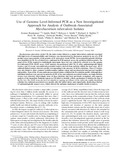| dc.description.abstract | Mycobacterium tuberculosis strain CH, the index isolate linked to a major tuberculosis outbreak associated with high levels of transmissibility and virulence, was characterized by microarray analysis by use of a PCR product array representative of the genome of M. tuberculosis strain H37Rv. Seven potential genomic deletions were identified in CH, five of which were confirmed by PCR analysis across the predicted deletion points. The panel of five PCRs required to individually interrogate these loci was collectively referred to as the genome level-informed PCR (GLIP) assay. GLIP analysis was performed with CH, 12 other epidemiologically linked isolates, and 43 recent, non-outbreak-associated isolates derived from patients within the local area. All 13 outbreak-linked isolates showed a profile corresponding to the presence of all five deletions. These 13 isolates were also found to share common variable-number tandem repeat and mycobacterial interspersed repetitive unit profiles. None of the 43 non-outbreak-associated isolates exhibited the five-deletion profile. Although three individual deletions were present in upwards of 44% of the non-outbreak-associated isolates, no single-deletion isolates were detected. Interestingly, none of these deletions had been previously recognized, and sequence analysis of the immediate flanking regions in CH failed to identify a likely mechanism of deletion for four of the five loci. The GLIP assay also proved valuable in ongoing surveillance of the outbreak, rapidly identifying a further two outbreak-associated cases months after the initial cluster and, importantly, dismissing a further 12 epidemiologically suspect cases, which allowed the optimum deployment of public health resources. | en |

